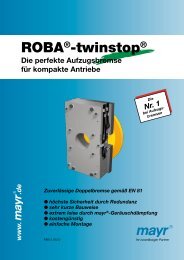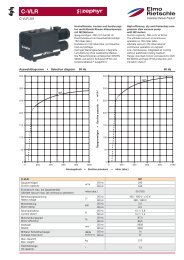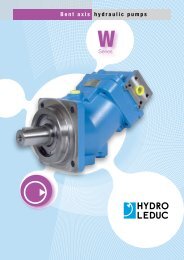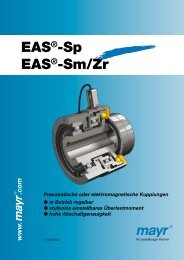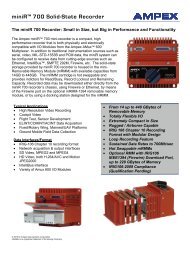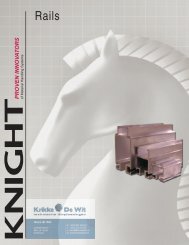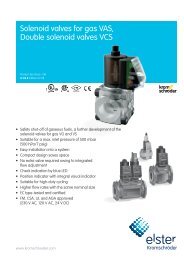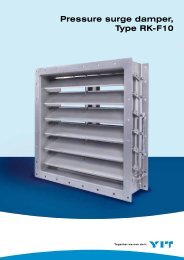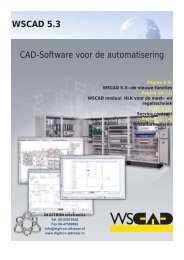CENTAX®-SEC - Industrial and Bearing Supplies
CENTAX®-SEC - Industrial and Bearing Supplies
CENTAX®-SEC - Industrial and Bearing Supplies
Erfolgreiche ePaper selbst erstellen
Machen Sie aus Ihren PDF Publikationen ein blätterbares Flipbook mit unserer einzigartigen Google optimierten e-Paper Software.
12. Allowable radial shaft misalignment<br />
This value specifies the maximum radial misalignment<br />
that is permissible on a continuous basis.<br />
However, such a misalignment produces a power loss<br />
in the coupling (see point 8) <strong>and</strong> reaction forces (see<br />
point 13), which have an effect on the adjacent bearings.<br />
For these reasons, the actual radial misalignment<br />
should be kept as low as possible.<br />
The specified value for the permissible radial shaft<br />
misalignment relates to a speed of 600 rpm. For other<br />
speeds, the speed (rpm) factor should be used in<br />
accordance with the following diagram.<br />
∆W r<br />
≤ ∆K r<br />
∙ S n<br />
The actual shaft misalignment may occasionally <strong>and</strong><br />
briefly rise to double the value of the continuously<br />
permissible shaft misalignment, e.g. during starting<br />
or shut down of flexibly mounted engines, or in<br />
heavy seas, etc.<br />
12. Zulässiger radialer Wellenversatz<br />
Dieser Wert gibt den Versatz an, der dauernd höchstens<br />
zulässig ist. Solcher Versatz erzeugt jedoch in<br />
der Kupplung Verlustleistung (siehe Punkt 8) und Reaktionskräfte<br />
(siehe Punkt 13), die auf die benachbarten<br />
Lagerstellen einwirken.<br />
Aus diesen Gründen sollte der tatsächliche radiale<br />
Versatz so gering wie möglich gehalten werden.<br />
Der angegebene Wert für den zulässigen radialen<br />
Wellenversatz bezieht sich auf die Drehzahl von 600<br />
min -1 .<br />
Für <strong>and</strong>ere Drehzahlen ist der Drehzahlfaktor nach<br />
nebenstehendem Diagramm einzusetzen.<br />
∆W r<br />
≤ ∆K r<br />
∙ S n<br />
Der tatsächliche Wellenversatz darf gelegentlich und<br />
kurzzeitig auf den doppelten Wert des dauernd zulässigen<br />
Wellenversatzes ansteigen, z.B. beim Anoder<br />
Abstellen von elastisch gelagerten Maschinen,<br />
starkem Seegang usw.<br />
S n<br />
1,0<br />
0,9<br />
0,8<br />
0,7<br />
0,6<br />
0,5<br />
0,4<br />
0 500 1000 1500 2000 2500 3000<br />
min -1<br />
Here the speed factor does not have to be taken into<br />
account.<br />
∆W r max<br />
= 2 ∙ ∆K r<br />
However for the 2 element series with failsafe device:<br />
∆W r max<br />
= 1 ∙ ∆K r<br />
13. Radial reaction force<br />
When radial misalignment of the coupling occurs, a<br />
radial reaction force F r<br />
results.<br />
F r<br />
= C r dyn<br />
∙ ∆W r<br />
The value C r dyn applies to rotating shafts <strong>and</strong> for a<br />
coupling temperature of 50° C.<br />
At higher temperatures the radial stiffness is also reduced<br />
according to the temperature factor S t3<br />
, as<br />
shown in the diagram on page 50.<br />
F r red<br />
= C r dyn<br />
∙ ∆W r<br />
∙ S t3<br />
Important:<br />
If there is significant radial misalignment, a check<br />
should be made to ensure that the bearings of the<br />
coupled shafts can withst<strong>and</strong> the radial reaction forces<br />
of the couplings.<br />
Dabei muß der Drehzahlfaktor nicht berucksichtigt<br />
werden.<br />
∆W r max<br />
= 2 ∙ ∆K r<br />
Bei Baureihen mit 2 Elementen und Durchdrehsicherung<br />
gilt jedoch: ∆W r max<br />
= 1 ∙ ∆K r<br />
13. Radiale Reaktionskraft<br />
Bei radialer Verlagerung der Wellen ergibt sich aus<br />
der Kupplung eine radiale Reaktionskraft F r<br />
.<br />
F r<br />
= C r dyn<br />
∙ ∆W r<br />
Der Wert C r dyn gilt für rotierende Wellen und für eine<br />
Kupplungstemperatur von 50° C.<br />
Bei höheren Temperaturen reduziert sich die radiale<br />
Steifigkeit entsprechend dem Temperaturfaktor S t3<br />
gemäß Diagramm auf Seite 50.<br />
F r red<br />
= C r dyn<br />
∙ ∆W r<br />
∙ S t3<br />
Falls beträchtlicher radialer Versatz vorliegt, ist zu<br />
prüfen, ob die Lagerungen der gekuppelten Wellen<br />
die radiale Reaktionskraft der Kupplung ertragen<br />
können.<br />
Wichtig: Es muß geprüft werden, ob die Lagerung<br />
der angeschlossenen Bauteile fur die auftretenden<br />
axialen und radialen Reaktionskräfte ausreichend dimensioniert<br />
sind.<br />
CX-<strong>SEC</strong>-app-7<br />
CATALOG CX-<strong>SEC</strong>-07-10



